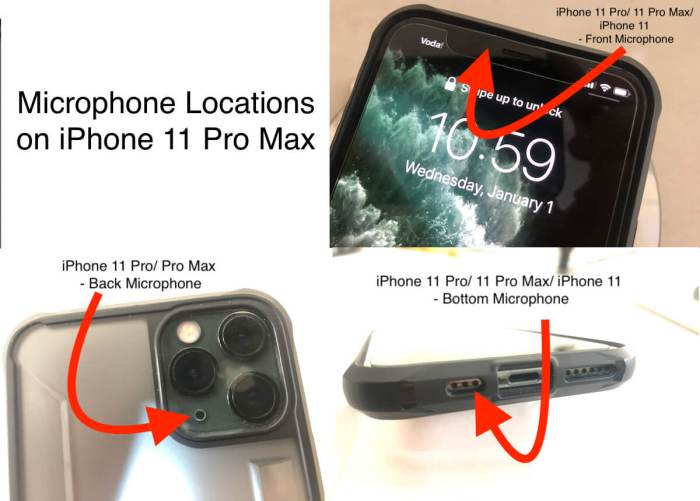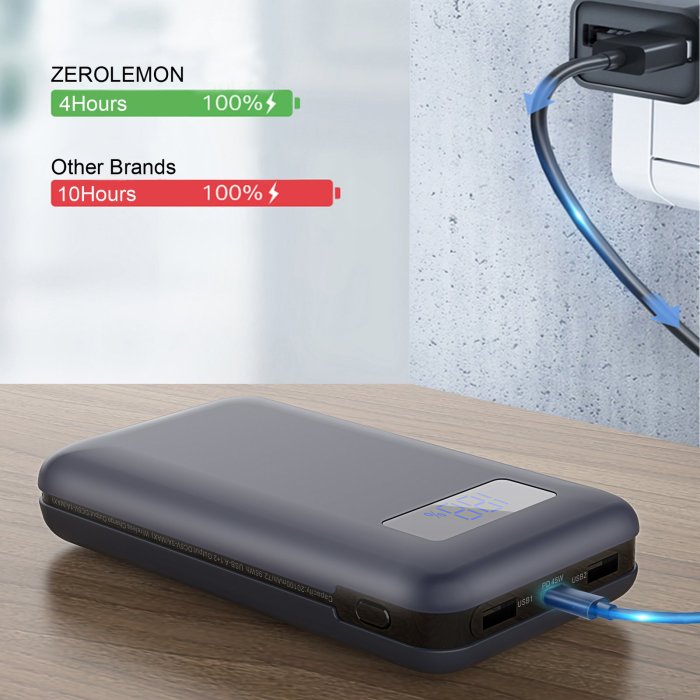Iphone 11 microphone location – The iPhone 11’s microphone location plays a crucial role in capturing high-quality audio. In this comprehensive guide, we delve into the details of its placement, types, capabilities, and troubleshooting tips, providing you with a thorough understanding of this essential component.
Location of Microphone on iPhone 11: Iphone 11 Microphone Location

The iPhone 11 features three microphones, strategically placed to capture audio from various directions and enhance overall sound quality.The primary microphone is situated at the bottom of the device, next to the Lightning port. This microphone is primarily used for phone calls and voice recordings.The
secondary microphone is located at the top of the device, near the rear camera module. This microphone is designed to capture ambient noise and reduce background interference during video recording.The third microphone is located on the back of the device, next to the flash module.
This microphone is primarily used for noise cancellation and audio zoom features.The placement of these microphones allows the iPhone 11 to capture high-quality audio for various applications, including phone calls, video recordings, and audio recordings.
Types of Microphones Used

The iPhone 11 incorporates an advanced audio system that utilizes multiple types of microphones to capture high-quality audio for various purposes.
There are three distinct types of microphones employed in the iPhone 11:
Beamforming Microphones
The iPhone 11 features three beamforming microphones strategically positioned around the device. These microphones work together to create a focused beam of sound reception, effectively isolating the speaker’s voice while minimizing background noise.
Beamforming microphones play a crucial role in:
- Improving call quality by reducing ambient noise during conversations
- Enhancing voice recordings by capturing clear and intelligible audio
- Providing spatial awareness for augmented reality (AR) applications
Bottom Microphone
The bottom microphone is located at the base of the iPhone 11. It primarily serves as a noise-canceling microphone, working in conjunction with the beamforming microphones to further reduce unwanted background noise.
The bottom microphone is particularly effective in:
- Minimizing wind noise during outdoor recordings
- Suppressing ambient sounds in noisy environments
- Enhancing audio quality for video recordings
Rear Microphone
The rear microphone is located on the back of the iPhone 11, adjacent to the camera module. It primarily functions as a secondary audio input, capturing ambient sounds and providing spatial context.
The rear microphone is utilized in:
- Capturing environmental sounds for video recordings
- Providing spatial audio effects in certain apps and games
- Enhancing audio quality during FaceTime calls
Audio Quality and Capabilities
The iPhone 11’s microphones capture high-quality audio, providing clear and detailed recordings. The phone’s advanced noise cancellation technology effectively reduces background noise, resulting in cleaner and more focused audio.
Directional sound recording is another notable feature, allowing the phone to focus on capturing audio from a specific direction. This is particularly useful in noisy environments, as it helps isolate the desired audio source and minimize distractions.
Factors Affecting Audio Quality
- Noise cancellation:The iPhone 11’s noise cancellation technology utilizes multiple microphones to identify and suppress background noise. This results in clearer recordings, especially in noisy environments.
- Directional sound recording:By using beamforming techniques, the phone’s microphones can focus on capturing audio from a specific direction. This feature is particularly useful for isolating voices in noisy environments or capturing audio from a specific source.
- Microphone placement:The placement of the microphones on the iPhone 11 contributes to its excellent audio quality. The microphones are strategically positioned to minimize interference and maximize sound capture.
Microphone Settings and Customization
The iPhone 11 offers various microphone settings to optimize audio capture for different scenarios. Users can access these settings through the “Settings” app.Under the “Microphone” section, users can adjust the following settings:
Noise Cancellation
Noise cancellation helps reduce background noise during audio recordings. Users can enable or disable this feature based on their preference.
Automatic Gain Control
Automatic Gain Control (AGC) adjusts the microphone’s sensitivity automatically to ensure consistent audio levels. Users can enable or disable this feature to fine-tune the microphone’s sensitivity manually.
Microphone Mode
The iPhone 11 provides two microphone modes: “Standard” and “Wide Stereo.” Standard mode captures audio from a single microphone, while Wide Stereo mode uses multiple microphones to create a wider stereo field. Users can choose the mode that best suits their recording needs.
Troubleshooting Microphone Issues
The microphone on the iPhone 11 is generally reliable, but it can sometimes encounter issues. These issues can range from minor annoyances to complete microphone failure. In this section, we will identify some of the most common microphone issues that users may encounter and provide troubleshooting steps to resolve them.
One of the most common microphone issues is that the microphone is not picking up any sound. This can be caused by a variety of factors, including a blocked microphone port, a loose connection between the microphone and the phone, or a software issue.
To troubleshoot this issue, try the following steps:
Clean the Microphone Port
The microphone port is located at the bottom of the iPhone 11. If the microphone port is blocked by dirt or debris, it can prevent the microphone from picking up sound. To clean the microphone port, use a soft brush or a cotton swab to gently remove any dirt or debris.
Be careful not to damage the microphone port.
Check the Microphone Connection
If the microphone port is not blocked, the next step is to check the connection between the microphone and the phone. To do this, gently wiggle the microphone cable to see if the microphone starts working. If the microphone starts working, the connection is loose and needs to be tightened.
To tighten the connection, use a small screwdriver to tighten the screws that hold the microphone in place.
Restart the iPhone, Iphone 11 microphone location
If the microphone is still not working, the next step is to restart the iPhone. Restarting the iPhone can clear any software issues that may be causing the microphone to malfunction. To restart the iPhone, press and hold the power button until the power off slider appears.
Slide the power off slider to the right to turn off the iPhone. Wait a few seconds and then press and hold the power button again to turn on the iPhone.
Microphone Applications and Use Cases

The iPhone 11’s microphones play a crucial role in enhancing various features and enabling a wide range of use cases.
Voice Calls
The iPhone 11’s microphones capture high-quality audio during voice calls, providing clear and intelligible conversations. They effectively reduce background noise and enhance voice clarity, even in noisy environments. This ensures seamless communication and an immersive calling experience.
Video Recording
The microphones on the iPhone 11 work in conjunction with the camera to capture high-quality audio during video recording. They enable users to create videos with clear and synchronized audio, enhancing the overall viewing experience. The microphones’ ability to reduce wind noise and isolate desired sounds ensures professional-grade audio quality in videos.
Audio Recording
The iPhone 11’s microphones are ideal for audio recording, allowing users to capture high-quality audio for various purposes. Whether recording music, podcasts, or interviews, the microphones deliver pristine and detailed sound. The ability to adjust microphone settings and apply real-time effects further enhances the audio recording capabilities of the iPhone 11.
Other Applications
Beyond the core use cases, the iPhone 11’s microphones also support a range of other applications:
-
- -*Siri
The microphones enable seamless interaction with Siri, Apple’s voice assistant. They accurately capture voice commands and provide quick responses, enhancing the overall user experience.
- -*Siri
-*Dictation
The microphones facilitate accurate dictation, allowing users to quickly and easily convert speech to text. This feature is particularly useful for composing messages, emails, and documents on the go.
-*Third-party Apps
Many third-party apps, such as music recording apps, video editing software, and language learning platforms, leverage the iPhone 11’s microphones to capture high-quality audio. This broadens the device’s functionality and empowers users to explore various creative and productive applications.
Final Wrap-Up
By understanding the location, types, and capabilities of the iPhone 11’s microphones, users can optimize their audio capture experience, ensuring crystal-clear communication and immersive multimedia experiences.
Answers to Common Questions
Where is the microphone located on the iPhone 11?
The iPhone 11 has three microphones: one on the bottom, one on the top, and one on the back near the camera module.
What types of microphones are used in the iPhone 11?
The iPhone 11 uses a combination of MEMS (Micro-Electro-Mechanical Systems) and condenser microphones.
How do I troubleshoot microphone issues on my iPhone 11?
Common microphone issues can be resolved by cleaning the microphone openings, checking for software updates, or restarting the device.


